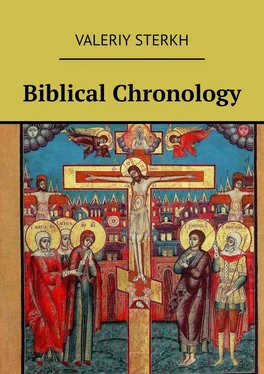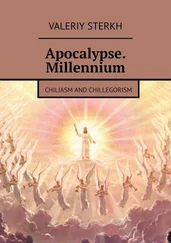“And he [Jehoahaz] reigned 3 months in Jerusalem” (2 Kings 23:31).
“And Pharaohnechoh made Eliakim the son of Josiah king in the room of Josiah his father, and turned his name to Jehoiakim, and took Jehoahaz away: and he came to Egypt, and died there” (2 Kings 23:34).
4912+31=4943
4954 (-596). The reign of Jehoiachin [Jeconiah], the Babylonian captivity, the beginning of the reign of Zedekiah
“And he [Jehoiakim] reigned 11 years in Jerusalem” (2 Kings 23:36).
“So Jehoiakim slept with his fathers: and Jehoiachin his son reigned in his stead” (2 Kings 24:6).
“And he [Jehoiachin] reigned in Jerusalem 3 months” (2 Kings 24:8).
“And he [Nebuchadnezzar] carried away Jehoiachin to Babylon, and the king’s mother, and the king’s wives, and his officers, and the mighty of the land, those carried he into captivity from Jerusalem to Babylon” (2 Kings 24:15).
“And the king of Babylon made Mattaniah his [Jehoiachin] father’s brother king in his stead, and changed his name to Zedekiah” (2 Kings 24:17).
4943+11=4954
4965 (-585). Judea is enslaved by Babylon
“And he [Zedekiah] reigned 11 years in Jerusalem” (2 Kings 24:18).
“So they took the king, and brought him up to the king of Babylon to Riblah; and they gave judgment upon him. And they slew the sons of Zedekiah before his eyes, and put out the eyes of Zedekiah, and bound him with fetters of brass, and carried him to Babylon. And in the fifth month, on the seventh day of the month, which is the nineteenth year of king Nebuchadnezzar king of Babylon, came Nebuzaradan, captain of the guard, a servant of the king of Babylon, unto Jerusalem: And he burnt the house of the LORD, and the king’s house, and all the houses of Jerusalem, and every great man’s house burnt he with fire. And all the army of the Chaldees, that were with the captain of the guard, brake down the walls of Jerusalem round about. Now the rest of the people that were left in the city, and the fugitives that fell away to the king of Babylon, with the remnant of the multitude, did Nebuzaradan the captain of the guard carry away” (2 Kings 25:6—11).
Modern science dates the conquest of Jerusalem by the Babylonian king Nebuchadnezzar II (c. 634 – 562 BNE) to 586 BNE.
4954+11=4965
5012 (-538). The conquest of Babylon by Cyrus II, the end of the Babylonian captivity of the Jews
“And they burnt the house of God, and brake down the wall of Jerusalem, and burnt all the palaces thereof with fire, and destroyed all the goodly vessels thereof. And them that had escaped from the sword carried he away to Babylon; where they were servants to him and his sons until the reign of the kingdom of Persia: To fulfil the word of the LORD by the mouth of Jeremiah, until the land had enjoyed her sabbaths: for as long as she lay desolate she kept sabbath, to fulfil 70 years” (2 Chron 36:19—21; compare Jer 25:11—12; Jer 29:10; Dan 9:2; Zech 1:12; Zech 7:4—5).
Modern science dates the conquest of Babylon by the Persian king Cyrus II (c. 593 – 530 BNE) to 539 BNE. As you may have noticed, the beginning of the seventy-year devastation of Judah falls on the date of the battle of Megiddo, 608 BNE. Three major captivities were experienced by the Jews in this period. The first was the exile inflicted at the hands of the Egyptian pharaoh Necho II in 608 BNE. The second one happened in 597 BNE, and the third one was in 586 BNE. The last two times they were captured by the Babylonian king Nebuchadnezzar II. Obviously, the 70-year-long period of the devastation of Judah is divided up into 11 years in Egypt and 59 years in Babylon.
4965+ (586—539) =5012
It is also important to note that 5550 years between the foundation of the world and the start of the new era is an approximate number. Taking into account the number of time intervals which make up the whole duration, as well as their number rounded to the accuracy of one year, the resulting error can roughly be estimated as plus or minus 50 years.
Modern-day scientists will, probably, disagree with dating the age the Earth as several thousand years. They will, most likely, cite scientific arguments in favor of the much older Solar system and Universe. It would be worth discussing this question separately, but it would probably require another book. At this time, let us limit ourselves to the information that we have from the Bible.
Section 3. Versions of the Gospel chronology
Christian sources on the life of Jesus Christ
The main sources of information on the life of Jesus Christ are the canonical Gospels written by the apostles Matthew, Mark, Luke and John.
The Gospel of Matthew was written about the third quarter of the 1st century. Tradition holds that it was written by Levi Matthew, the son of Alphaeus, one of the Twelve (see Mt 9:9; Mk 2:14; Lk 5:27). Originally it was written in the old Hebrew, but later it was translated into Greek and became widely accepted.
“So, Matthew wrote the Gospel for the Jews in their own language, while Peter and Paul were preaching in Rome and founded the Church” (Irenaeus of Lyons. Against Heresies, 3,1,1; compare Eusebius of Caesarea. Church History, 5,8).
“Initially Matthew preached the Gospel to the Jews; but then he took it to other nations, though it was written in his own tongue. When summoned to go elsewhere, he left them with his Scripture” (Eusebius of Caesarea. Church History, 3,24,6).
“Matthew the Apostle, who was also called Levi, used to be a tax-collector; he complied the Gospel of Jesus Christ for the sake of spiritual cleansing of believers. At first, it was published in Judea in Hebrew, but later someone translated it into Greek [compare Eusebius of Caesarea, Church History, 3,39,16]. The Hebrew version survived to the present day [around the beginning of the 5th century] in the Library of Caesarea [Caesarea of Palestine], so arduously created and maintained by Pamphilus [of Caesarea]. I also had the opportunity to get the book described for me by the Nazarene from the Syrian town of Berea who had been using it. It must be noted that this Gospel-writer, in quoting the Old Testament testimonies, whether himself or on behalf of our Lord and Savior, always follows the Hebrew text of the Covenant, not the authority of the translators of the Septuagint. Therefore, there are the following two versions: ‘Out of Egypt I have called my son’ [Mt 2:15; Hos 11:1] and: ‘He will be called a Nazorean’ [Mt 2:23; Is 11:1 ; compare Num 6:21; Judg 13:5; 1 Sam 1:11; Am 2:11—12]” (Jerome of Stridon. On Famous Men, 3).
The Gospel of Mark was written around the middle of the 1st century. According to the tradition, it was written by John Mark (see Act 12:12), the nephew of Barnabas (see Col 4:10), who was one of the seventy apostles and a co-worker of Peter (see 1 Pet 5:13). It is regarded as the earliest of the four Gospels. It is the shortest of them all, and it was used as a source for writing the Gospels of Matthew and Luke.
“These are the words of the presbyter [Papias of Hierapolis]: ‘Mark was the interpreter of Peter; he accurately recorded everything that the Lord had said and done, but not in order, for he himself did not hear the Lord speak, neither did he walk with Him. Later he accompanied Peter who taught as he saw fit based on the circumstances, and did not necessarily relate the words of Christ in order. In recording everything the way he remembered it, Mark did not err against the truth. His only concern was not to miss or misrepresent anything.’ That is what Papias said concerning Mark” (Eusebius of Caesarea. Church History, 3,39,15—16).
“Peter and Paul preached in Rome and founded a church there. After their departure, Mark, Peter’s disciple and interpreter, passed down to us in writing everything that Peter had taught” (Irenaeus of Lyons. Against Heresies, 3,1,1; compare Eusebius of Caesarea. Church History, 5,8).
Читать дальше












